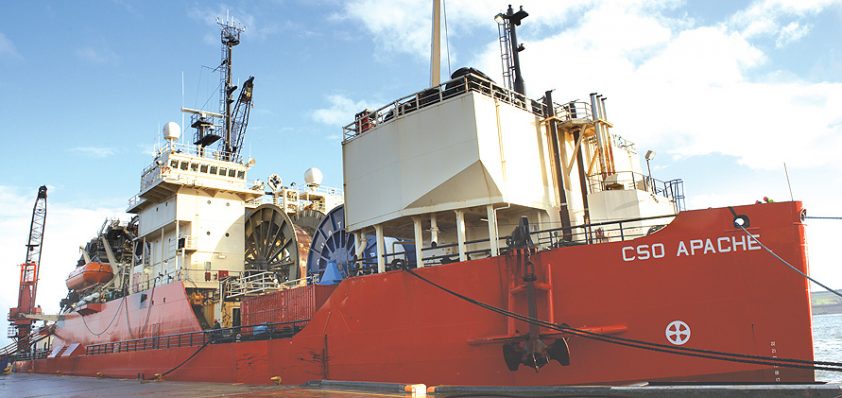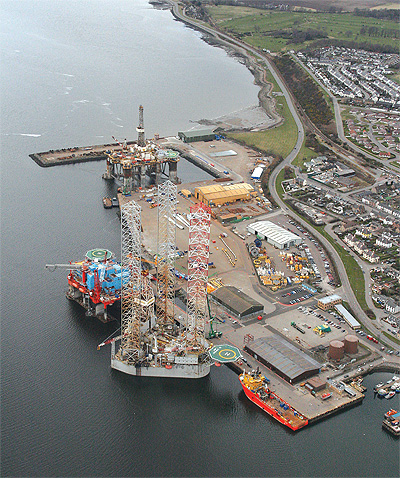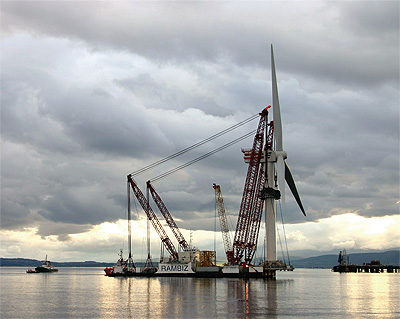
Cromarty Firth Port Authority: Scotland’s Premier Hub for Oil & Gas and Renewables
First port of call
The Cromarty Firth Port Authority exists to develop, improve and maintain the Cromarty Firth as a port for the benefit of its customers and stakeholders.
Invergordon has been used as a port throughout history, with official harbour works first initiated in 1785. During the 18th and 19th centuries the port was used mainly for the shipping of grain and livestock to the south, now the port has a range of facilities and capabilities for the oil and gas industry. The primary asset of the Firth is its deep sheltered waters, which have accommodated battleships, oil rigs, supertankers and cruise ships throughout its history.
 Ken Gray port manager and harbour master explains the port’s functions: “The Cromarty Firth Port Authority is a trust port and as such has both statutory and non-statutory functions. The statutory functions are as a port authority; regulating the movement of traffic to maintain safe navigation, environmental issues and emergency planning such as oil pollution response within the area. The non-statutory functions include the Invergordon Service Base, approximately 450 people work there full time undertaking inspection, repair and maintenance (IRM) work, this year we’ll have 360 rig days over six projects.
Ken Gray port manager and harbour master explains the port’s functions: “The Cromarty Firth Port Authority is a trust port and as such has both statutory and non-statutory functions. The statutory functions are as a port authority; regulating the movement of traffic to maintain safe navigation, environmental issues and emergency planning such as oil pollution response within the area. The non-statutory functions include the Invergordon Service Base, approximately 450 people work there full time undertaking inspection, repair and maintenance (IRM) work, this year we’ll have 360 rig days over six projects.
“We also undertake subsea activities mainly in the North Sea northern sector, in addition to pipe spooling at Highland Deephaven and cruise operations, of which we had 52 cruise ships with in excess of 48,000 cruise passengers in 2008,” he says. “We have strengthened quay areas capable of accommodating lift up to 1000 tonnes; hard standing and project land is available adjoining the quay area for both storage and assembly, anchor and chain inspection, survey work, replacement of winches and all the various machinery that is required.”
The Port Authority is continuously improving the port with over 36 miles of coastline within the port limits. It has developed as one of the premier ports in Europe for oil rig inspection, repair and maintenance and is the leading service base for the subsea industry. Ken tells European Oil and Gas why he feels it is so successful: “We operate a multi-user facility which allows our customers to have a flexible working environment allowing time scales to be met, which we feel is very important at this time of high demand for equipment utilisation within the IRM market. We can accommodate two rigs alongside at any one time and on occasions have had three rigs in to undertake IRM work. We also have the deepest sheltered water in Scotland; in the past we had up to 18 rigs stacked in the firth but due to the high demand for oil exploration throughout the world there are currently no rigs permanently anchored in the Firth. We are just about to reach our 600th rig since IRM work first started in the Firth in the early 1980s, this is a big milestone for us and we intend to celebrate it fully from a PR point of view but also for our employees.”
The oil and gas industry has been affected world wide by the persistent increase in oil prices, however Ken believes that the Cromarty Firth Port Authority will remain successful in the industry: “Our major challenge at the moment is the price of oil, as long as it stays at its present level we will continue to receive a considerable amount of work. However the type of work is changing, no  longer are large platforms being constructed; previously there were 5,000 employees at the Nigg Fabrication yard in the Firth now the work is in the subsea module fabrication and IRM. We have had to spend a considerable amount of investment in the Service Base to improve facilities and I am confident we will see a return on this investment.
longer are large platforms being constructed; previously there were 5,000 employees at the Nigg Fabrication yard in the Firth now the work is in the subsea module fabrication and IRM. We have had to spend a considerable amount of investment in the Service Base to improve facilities and I am confident we will see a return on this investment.
The Cromarty Firth’s location and ecological constitution make this an extremely important issue and the Port Authority is meeting it head on: “We feel the environment is very important because the firth has two sites of special scientific interest (SSSI’s), a ramsar site, and it joins to a marine special area of conservation (SAC). We have to be very environmentally aware to ensure that the commercial operations of the port don’t interfere with the environmental issues. To do that we have introduced an environmental management plan which will allow us to improve the education and our profile as far as being environmentally aware,” Ken explains.
“Our long term vision for the company is to build on our current experience in the logistics areas of the renewables market. We’ve completed eight renewable projects so far, some quite large for both offshore and onshore delivery to inland wind farms. 2007 saw the assembly of the Beatrice experimental wind farm at the Nigg fabrication yard and its shipment to site. We see ourselves using the expertise we have gained from subsea activities to move into more deepwater wind farm projects, as well as wave and tidal renewable energy,” he continues.
In looking to the future the environmental management plan includes a five per cent cut in energy consumption throughout operations, a five per cent rise in recycling and work with the Highland Council to encourage operators to reduce air and noise pollution and monitor water quality. A goal that will ensure Cromarty Firth Port Authority’s continued high standing in the oil and gas industry.
Cromarty Firth Port Authority
Services Port services